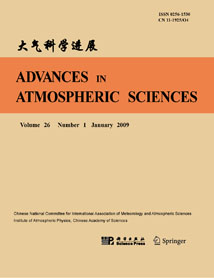| [1] |
Li Jun, Zhou Fengxian, Gao Qinghuai,
1990: Delineation of Mesoscale Features of Ocean on Satellite IR Image, ADVANCES IN ATMOSPHERIC SCIENCES, 7, 423-432.
doi: 10.1007/BF03008872
|
| [2] |
LI Pingyang, JIANG Weimei, SUN Jianning, YUAN Renmin,
2003: A Laboratory Modeling of the Velocity Field in the Convective Boundary Layer with the Particle Image Velocimetry Technique, ADVANCES IN ATMOSPHERIC SCIENCES, 20, 631-637.
doi: 10.1007/BF02915506
|
| [3] |
Li Jun, Zhou Fengxian,
1992: On Accurate Detection of Oceanic Features from Satellite IR Data Using ICSED Method, ADVANCES IN ATMOSPHERIC SCIENCES, 9, 373-382.
doi: 10.1007/BF02656948
|
| [4] |
Seung-Woo LEE, Dong-Kyou LEE,
2011: Improvement in Background Error Covariances Using Ensemble Forecasts for Assimilation of High-Resolution Satellite Data, ADVANCES IN ATMOSPHERIC SCIENCES, 28, 758-774.
doi: 10.1007/s00376-010-0145-6
|
| [5] |
Shengzhe CHEN, Jiping LIU, Yifan DING, Yuanyuan ZHANG, Xiao CHENG, Yongyun HU,
2021: Assessment of Snow Depth over Arctic Sea Ice in CMIP6 Models Using Satellite Data, ADVANCES IN ATMOSPHERIC SCIENCES, 38, 168-186.
doi: 10.1007/s00376-020-0213-5
|
| [6] |
Yan Shaojin, Peng Yongqing, Wang Jianzhong,
1991: Determination of Kolmogorov Entropy of Chaotic Attractor Included in One-Dimensional Time Series of Meteorological Data, ADVANCES IN ATMOSPHERIC SCIENCES, 8, 243-250.
doi: 10.1007/BF02658098
|
| [7] |
P.C.S. Devara, P. Ernest Raj,
1992: Atmospheric NO2 Concentration Measurements Using Differential Absorption Lidar Technique, ADVANCES IN ATMOSPHERIC SCIENCES, 9, 73-82.
doi: 10.1007/BF02656932
|
| [8] |
Kefeng ZHU, Ming XUE, Yujie PAN, Ming HU, Stanley G. BENJAMIN, Stephen S. WEYGANDT, Haidao LIN,
2019: The Impact of Satellite Radiance Data Assimilation within a Frequently Updated Regional Forecast System Using a GSI-based Ensemble Kalman Filter, ADVANCES IN ATMOSPHERIC SCIENCES, 36, 1308-1326.
doi: 10.1007/s00376-019-9011-3
|
| [9] |
Fang Xianjin,
1992: Spectral and Anisotropic Corrections for GMS Satellite Data, ADVANCES IN ATMOSPHERIC SCIENCES, 9, 287-298.
doi: 10.1007/BF02656939
|
| [10] |
Peng ZHANG, Qifeng LU, Xiuqing HU, Songyan GU, Lei YANG, Min MIN, Lin CHEN, Na XU, Ling Sun, Wenguang BAI, Gang MA, Di XIAN,
2019: Latest Progress of the Chinese Meteorological Satellite Program and Core Data Processing Technologies, ADVANCES IN ATMOSPHERIC SCIENCES, 36, 1027-1045.
doi: 10.1007/s00376-019-8215-x
|
| [11] |
ZENG Heqing, JIA Gensuo,
2013: Impacts of Snow Cover on Vegetation Phenology in the Arctic from Satellite Data, ADVANCES IN ATMOSPHERIC SCIENCES, 30, 1421-1432.
doi: 10.1007/s00376-012-2173-x
|
| [12] |
Li Jun, Wang Luyi, Zhou Fengxian,
1993: Convective and Stratiform Cloud Rainfall Estimation from Geostationary Satellite Data, ADVANCES IN ATMOSPHERIC SCIENCES, 10, 475-480.
doi: 10.1007/BF02656972
|
| [13] |
Ruiyao CHEN, Ralf BENNARTZ,
2021: Rainfall Algorithms Using Oceanic Satellite Observations from MWHS-2, ADVANCES IN ATMOSPHERIC SCIENCES, 38, 1367-1378.
doi: 10.1007/s00376-020-0258-5
|
| [14] |
LIU Xiaoyang, MAO Jietai, ZHU Yuanjing, LI Jiren,
2003: Runoff Simulation Using Radar and Rain Gauge Data, ADVANCES IN ATMOSPHERIC SCIENCES, 20, 213-218.
doi: 10.1007/s00376-003-0006-7
|
| [15] |
Michael B. RICHMAN, Lance M. LESLIE, Theodore B. TRAFALIS, Hicham MANSOURI,
2015: Data Selection Using Support Vector Regression, ADVANCES IN ATMOSPHERIC SCIENCES, 32, 277-286.
doi: 10.1007/s00376-014-4072-9
|
| [16] |
Yaodeng CHEN, Jie SHEN, Shuiyong FAN, Deming MENG, Cheng WANG,
2020: Characteristics of Fengyun-4A Satellite Atmospheric Motion Vectors and Their Impacts on Data Assimilation, ADVANCES IN ATMOSPHERIC SCIENCES, 37, 1222-1238.
doi: 10.1007/s00376-020-0080-0
|
| [17] |
Keyi CHEN, Niels BORMANN, Stephen ENGLISH, Jiang ZHU,
2018: Assimilation of Feng-Yun-3B Satellite Microwave Humidity Sounder Data over Land, ADVANCES IN ATMOSPHERIC SCIENCES, 35, 268-275.
doi: 10.1007/s00376-017-7088-0
|
| [18] |
Jincheng WANG, Xingwei JIANG, Xueshun SHEN, Youguang ZHANG, Xiaomin WAN, Wei HAN, Dan WANG,
2023: Assimilation of Ocean Surface Wind Data by the HY-2B Satellite in GRAPES: Impacts on Analyses and Forecasts, ADVANCES IN ATMOSPHERIC SCIENCES, 40, 44-61.
doi: 10.1007/s00376-022-1349-2
|
| [19] |
Fabien CARMINATI, Nigel ATKINSON, Brett CANDY, Qifeng LU,
2021: Insights into the Microwave Instruments Onboard the Fengyun 3D Satellite: Data Quality and Assimilation in the Met Office NWP System, ADVANCES IN ATMOSPHERIC SCIENCES, 38, 1379-1396.
doi: 10.1007/s00376-020-0010-1
|
| [20] |
Bohua Huang, James L. Kinter III, Paul S. Schopf,
2002: Ocean Data Assimilation Using Intermittent Analyses and Continuous Model Error Correction, ADVANCES IN ATMOSPHERIC SCIENCES, 19, 965-992.
doi: 10.1007/s00376-002-0059-z
|















 AAS Website
AAS Website 
 AAS WeChat
AAS WeChat 
 DownLoad:
DownLoad: